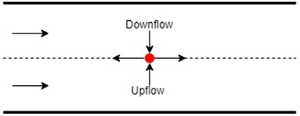Article contents
Spatio-temporal dynamics of a two-layer pressure-driven flow subjected to a wall-normal temperature gradient
Published online by Cambridge University Press: 15 February 2023
Abstract

The present study investigates the linear spatio-temporal and weakly nonlinear stability of a pressure-driven two-layer channel flow subjected to a wall-normal temperature gradient commonly encountered in industrial applications. The liquid–liquid interface tension is assumed to be a linearly decreasing function of temperature. The study employs both numerical (pseudo-spectral method) and long-wave approaches. The general linear stability analysis (GLSA) predicts shear-flow and thermocapillary modes that arise due to the imposed pressure and temperature gradients, respectively. The previous stability analyses of the same problem predicted a negligible effect of the pressure-driven flow on the linear stability of the system. However, the GLSA reveals stabilising and destabilising effects of the pressure-driven flow depending on the viscosity ratio ( $\mu _r$), thermal conductivity ratio (
$\mu _r$), thermal conductivity ratio ( $\kappa _r$), interface position (
$\kappa _r$), interface position ( $H$) and the sign of the imposed temperature gradient (
$H$) and the sign of the imposed temperature gradient ( $\beta _1$). The analysis predicts a range of
$\beta _1$). The analysis predicts a range of  $H$ for given
$H$ for given  $\mu _r$ and
$\mu _r$ and  $\kappa _r$, which can not be stabilised by the thermocapillarity. The numerically predicted long-wave instability is then captured using the long-wave asymptotic approach. The arguments based on the physical mechanism further successfully explain the role of
$\kappa _r$, which can not be stabilised by the thermocapillarity. The numerically predicted long-wave instability is then captured using the long-wave asymptotic approach. The arguments based on the physical mechanism further successfully explain the role of  $\mu _r$,
$\mu _r$,  $\kappa _r$,
$\kappa _r$,  $H$, the sign of
$H$, the sign of  $\beta _1$ and the interaction between the velocity and temperature perturbations in stabilising/destabilising the flow. The spatio-temporal analysis reveals the dominance of the spanwise mode in causing the absolutely unstable flow. The weakly nonlinear analysis reveals a subcritical pitchfork bifurcation without shear flow. However, with the shear flow, the streamwise mode undergoes a supercritical Hopf bifurcation.
$\beta _1$ and the interaction between the velocity and temperature perturbations in stabilising/destabilising the flow. The spatio-temporal analysis reveals the dominance of the spanwise mode in causing the absolutely unstable flow. The weakly nonlinear analysis reveals a subcritical pitchfork bifurcation without shear flow. However, with the shear flow, the streamwise mode undergoes a supercritical Hopf bifurcation.
- Type
- JFM Papers
- Information
- Copyright
- © The Author(s), 2023. Published by Cambridge University Press
References
REFERENCES
- 2
- Cited by



